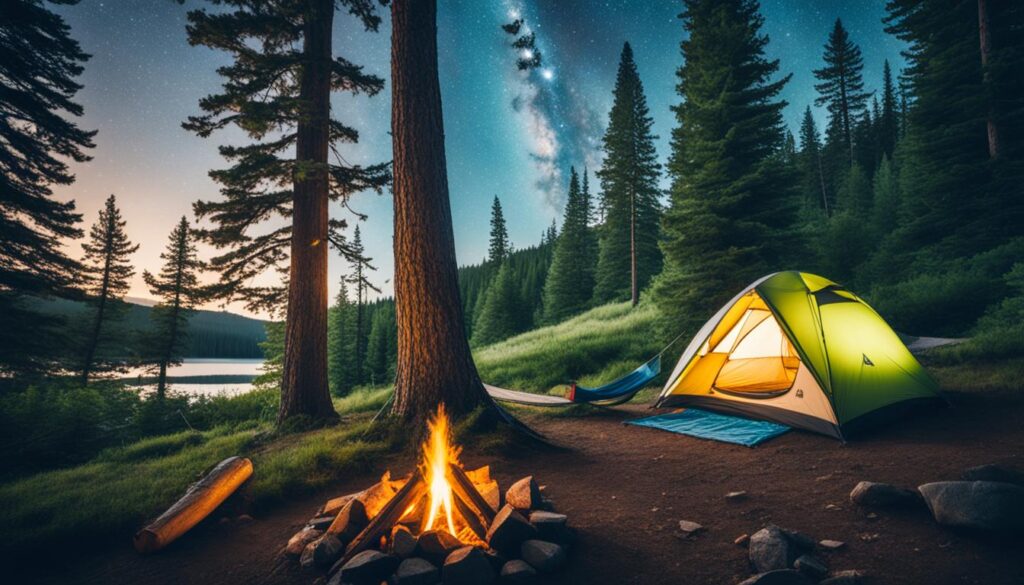When it comes to camping, getting a good night’s sleep is essential for an enjoyable outdoor experience. Investing in the right gear can make all the difference. From the quality of your sleeping bag and sleeping mat to the comfort of your pillow and bedding, there are several factors to consider when choosing the best things to sleep on when camping. By following these tips and recommendations, you can elevate your outdoor rest and ensure a cozy night under the stars.
Key Takeaways:
- Invest in high-quality camping gear including a tent, sleeping bag, and sleeping mat.
- Layer up for warmth in cold weather camping by placing extra clothing on top of your sleeping bag.
- Create a comfortable sleeping environment by controlling temperature, light, and sound.
- Choose the right sleeping surface such as sleeping pads, camping air mattresses, or hammocks.
- Consider your needs and preferences when selecting camping sleep gear and equipment.
One of the most important aspects of a comfortable sleep while camping is investing in good gear. Your camping essentials should include a high-quality tent, sleeping bag, and sleeping mat.
When choosing your gear, consider factors such as weight, insulation, and durability. Inflatable sleeping mats are lightweight and offer a combination of low weight and sleeping comfort. Down sleeping bags provide the best warmth-to-weight ratio, while synthetic bags are better in damp conditions.
Choose a three-season tent that suits your needs, whether it’s a dome tent for exposed conditions or a tunnel tent for rainy weather.

Camping Gear Comparison
| Item | Weight | Insulation | Durability |
|---|---|---|---|
| Sleeping Mat | 1.5 lbs | Inflatable | High |
| Sleeping Bag | 2 lbs | Down | Medium |
| Tent | 4.5 lbs | Three-season | High |
By investing in reliable camping gear, you can ensure a more comfortable and enjoyable camping experience, allowing you to get a good night’s sleep in the great outdoors.
Layer Up for Warmth
When camping in cold weather, it’s important to layer up for warmth. Rather than wearing too many layers inside your sleeping bag, which can affect its insulating power, place the extra layers on top of the sleeping bag. This allows you to adjust your clothing according to the temperature without compromising the effectiveness of your sleeping bag.
Choose breathable and moisture-wicking clothing for optimal comfort. These types of clothing help regulate body temperature and prevent sweat from building up, keeping you dry and warm throughout the night. Opt for thermal base layers made of materials like merino wool or synthetic fabrics, as they offer excellent insulation. Layer up with a fleece or down jacket and thermal pants for added warmth.
The extremities are more prone to getting cold, so don’t forget to wear a warm hat and thick socks to keep your head and feet cozy. A good pair of gloves or mittens is also essential to protect your hands from the cold.
Layering up properly is the key to staying warm and comfortable when camping in cold weather.- Expert Camper
By layering up and choosing the right camping clothing, you can ensure that you stay warm and comfortable during your cold weather camping adventure. Remember to remove or add layers as needed to maintain the right level of warmth. Now, let’s move on to optimizing your sleeping environment to enhance your camping sleep experience.
Recommended Camping Clothing for Layering:
- Thermal base layers
- Fleece or down jacket
- Thermal pants
- Warm hat
- Thick socks
- Gloves or mittens
Benefits of Layering Up for Warmth:
- Allows for temperature adjustment without affecting sleeping bag insulation.
- Provides optimal comfort and flexibility in varying weather conditions.
- Helps regulate body temperature and prevent overheating or excessive cooling.
- Protects extremities from the cold, keeping you cozy throughout the night.
To give you a visual representation of the layering concept, here’s an illustration:

Optimize your Sleeping Environment
Creating a comfortable sleeping environment is crucial for a good night’s sleep while camping. Paying attention to factors such as temperature, light, and sound can significantly improve your sleep quality and overall camping experience.
Firstly, maintaining an optimal temperature is essential. Aim for a temperature range of 65 to 68 degrees Fahrenheit in your camping sleep environment. This temperature range promotes a comfortable sleep environment and helps prevent overheating or feeling too cold. Consider choosing a sleeping bag that is suitable for the prevailing weather conditions to ensure maximum comfort and insulation.
Next, it’s important to manage the light in your camping sleep area. Bright light can disrupt your sleep cycle and make it challenging to fall asleep. To block out unwanted light, consider using an eye mask or tent shades. These simple solutions can help create a darkened sleep environment, promoting deep and restful sleep even during daylight hours.
Additionally, sound can be a significant factor affecting your sleep quality while camping. Unfamiliar sounds or noises from nearby campers can disturb your sleep and leave you feeling restless. To counter this, portable white noise machines or smartphone apps can be highly effective in drowning out unwanted noise and creating a soothing and relaxing atmosphere for sleep.

To summarize, optimizing your camping sleep environment involves managing temperature, light, and sound. By maintaining an ideal temperature, blocking out light, and using techniques to mask unfamiliar sounds, you can enhance the quality of your sleep and wake up feeling refreshed and energized for your camping adventures.
Choose the Right Sleeping Surface
When it comes to camping, the right sleeping surface can make all the difference in your comfort and quality of sleep. There are several options to consider, each with its own benefits and features.
Sleeping pads are a popular choice for campers looking for insulation and cushioning. They come in different types, such as foam, self-inflating, and inflatable, catering to various preferences and terrains. Additionally, camping air mattresses offer the feel of sleeping on a regular bed, making them a favorite among car campers.
If you’re looking for convenience and elevation, camping cots provide a sturdy and comfortable sleeping option. Sleeping bags, on the other hand, remain a timeless choice for camping enthusiasts, offering warmth and coziness on chilly nights.
For a unique and relaxing experience, hammocks are a fantastic alternative. Perfect for lounging and sleeping under the stars, hammocks offer a lightweight and comfortable solution for campers seeking a bit of adventure.
Consider your needs, preferences, and the specific requirements of your camping trip when choosing the right sleeping surface. Whether it’s a sleeping pad, camping air mattress, camping cot, sleeping bag, or hammock, ensure your choice aligns with your comfort and enhances your overall camping experience.
FAQ
What are the best things to sleep on when camping?
The best things to sleep on when camping include sleeping pads, camping air mattresses, camping cots, sleeping bags, and hammocks. The choice depends on your preferences and the camping conditions.
What gear should I invest in for a comfortable sleep while camping?
Investing in good gear is essential for a comfortable sleep while camping. Consider getting a high-quality tent, sleeping bag, and sleeping mat. Choose gear that is lightweight, insulated, and durable.
How can I stay warm while camping in cold weather?
Layer up for warmth while camping in cold weather. Instead of wearing too many layers inside your sleeping bag, place the extra layers on top of the sleeping bag to maintain its insulating power. Choose breathable and moisture-wicking clothing, wear a warm hat and socks, and adjust your clothing according to the temperature.
How can I optimize my sleeping environment while camping?
To optimize your sleeping environment while camping, pay attention to factors such as temperature, light, and sound. Aim for a temperature range of 65 to 68 degrees Fahrenheit. Use portable white noise machines or smartphone apps to mask unfamiliar sounds. Use eye masks or tent shades to block out unwanted light.
What are the different options for sleeping surfaces when camping?
There are several options for sleeping surfaces when camping, including sleeping pads, camping air mattresses, camping cots, sleeping bags, and hammocks. Each option offers unique benefits and comfort levels. Consider your needs and preferences when choosing the right sleeping surface for your camping adventure.






